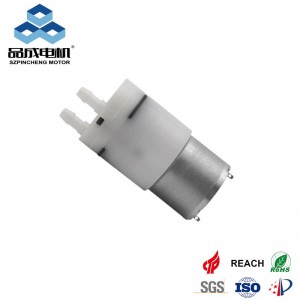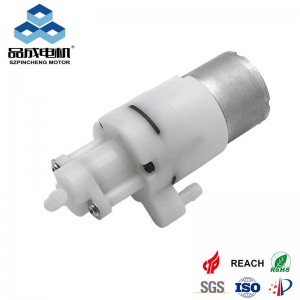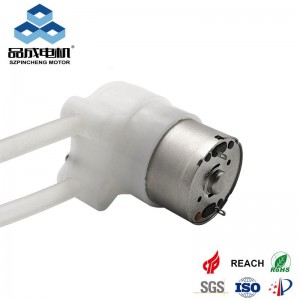Micro diaphragm pumps power everything from portable medical devices to industrial automation—but their voltage rating (6V, 12V, or 24V) isn’t just a power input. It fundamentally alters flow rates, efficiency, lifespan, and system integration. Here’s how to optimize your design.
Core Performance Impacts: Voltage vs. Power Efficiency
Voltage directly governs current draw (A), which dictates power consumption (W) and heat generation:
-
Current Reduction at Higher Voltage:
A 24V pump draws ~50% less current than a 12V model at identical power output. For example:-
SEAFLO’s 12V/5.0LPM pump draws 8.5A (max), while its 24V equivalent uses just 4.48A for the same flow5.
-
TF30D-D pumps show similar trends: 6V (0.4A) → 12V (0.24A) → 24V (0.15A) under no-load conditions6.
-
-
Power Loss Minimization:
Power loss = I²R (current² × resistance). Halving current reduces resistive losses by 75%, critical for battery-powered systems.
Result: 24V systems extend battery life by 30–50% vs. 12V and 200% vs. 6V in continuous-duty applications68.
Voltage vs. Key Performance Metrics
| Parameter | 6V Systems | 12V Systems | 24V Systems |
|---|---|---|---|
| Max Flow Rate | ≤0.8L/min (TF30D-D)6 | ≤12.5L/min (SEAFLO 41 series)5 | ≤12.5L/min (equivalent to 12V) |
| Current Draw | High (e.g., 0.4A no-load) | Moderate (e.g., 0.24A no-load) | Low (e.g., 0.15A no-load) |
| Motor Heat | High (↑ wear) | Moderate | Low (↑ lifespan) |
| Cable Cost | Low (thin wires OK) | Medium | High (thicker wires) |
| Ideal Use Case | Portable, low-power devices | Mid-range applications | Industrial/24/7 systems |
Engineering Tradeoffs: Beyond Efficiency
1. Torque-Speed Dynamics
-
6V/12V: Higher current → faster motor acceleration. Ideal for intermittent tasks (e.g., medical dosing)3.
-
24V: Sustains high torque at low RPMs. Optimal for continuous pressure-demanding tasks (e.g., RO filtration, coolant circulation)15.
2. Component Stress & Lifespan
-
High-current (6V/12V) systems heat motor windings faster, accelerating insulation degradation. Tests show 24V pumps last 2–3× longer than 12V equivalents under identical loads8.
-
Low-voltage pumps risk voltage sag under load, causing erratic diaphragm motion and valve chatter8.
3. System Integration Costs
-
6V/12V: Simple power supplies; ideal for consumer electronics (e.g., Shinano Kenshi’s 3V–5V pumps)3.
-
24V: Requires robust wiring but enables smaller controllers and IoT integration (e.g., BLDC motor control)6.
Optimization Strategies by Voltage Class
6V Pumps: Maximizing Portability
-
Use Case: Wearable drug delivery, environmental sensors.
-
Fix Heat Issues:
-
Pair with pulse-width modulation (PWM) to limit duty cycles8.
-
Select thermally stable diaphragms (e.g., graphene-coated PTFE)6.
-
12V Pumps: Balancing Power & Flexibility
-
Use Case: Automotive systems, home appliances.
-
Boost Efficiency:
-
Add buffer tanks to reduce ON/OFF cycling (cuts current spikes by 70%)8.
-
Use soft-start circuits to prevent mechanical shock8.
-
24V Pumps: Industrial-Grade Reliability
-
Use Case: Factory automation, high-pressure sprayers.
-
Prevent Voltage Spikes:
-
Install TVS diodes to protect control boards.
-
Specify brushless DC motors (e.g., TF30D-D) for 15,000+ hour lifespans6.
-
Real-World Data: Voltage in Action
-
Medical Analyzer (6V):
Shinano Kenshi’s 3V micropump (9g, 30mL/min flow) powers blood glucose monitors for 6+ months on coin cells3. -
RO Filtration (24V):
Delta’s 36V commercial pump achieves 1,000-gallon/day capacity with 35% lower heat vs. 12V models1. -
Fuel Cell (12V):
StarMicronics’ 12V SDMP301 (1.5mL/min) feeds methanol to laptop fuel cells without voltage sag4.
Selection Guidelines: Matching Voltage to Your Application
-
Choose 6V if:
-
Size/weight are critical (e.g., wearables).
-
Flow demands are low (<1L/min).
-
-
Choose 12V if:
-
Balanced power/cost needed (e.g., automotive, solar showers).
-
Flow ≤12L/min with moderate pressure (≤35PSI)5.
-
-
Choose 24V if:
-
Efficiency/lifespan are priorities (e.g., industrial IoT).
-
High pressure (>60PSI) or 24/7 operation is required7.
-
Future Trends: Smarter Voltage Adaptation
-
Multi-Voltage Pumps: Auto-switching designs (e.g., 12V/24V) for hybrid power systems (2026 release).
-
Integrated DC-DC Converters: Maintain peak efficiency across 6V–24V inputs (prototype tested by Pinmotor).
"Voltage isn’t just a spec—it’s the DNA of your pump’s performance. Match it wrong, and efficiency bleeds; match it right, and reliability soars."
Optimize Your System:
➔ Explore Voltage-Specific Micro Pumps
➔ Download Voltage Selection Toolkit
you like also all
Read More News
Post time: Jul-16-2025




